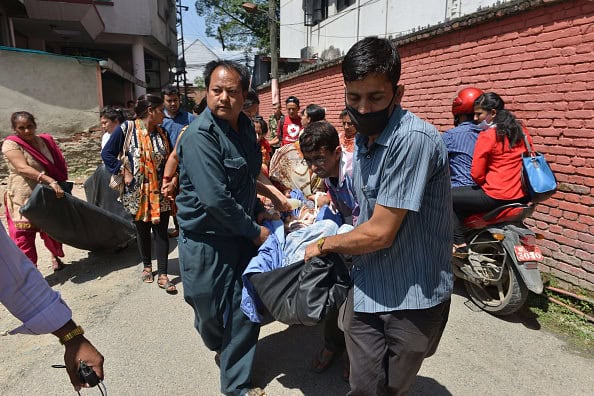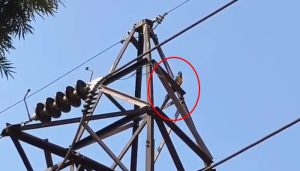KATHMANDU (Web Desk) – A major earthquake hit a remote region of Nepal on Tuesday, killing at least 40 people, triggering landslides and toppling buildings less than three weeks after the Himalayan nation was ravaged by its worst quake in decades.
Information was slow to reach the capital, Kathmandu, but officials and aid workers said they expected the death toll to almost certainly rise.
Within a few hours, the government confirmed that 42 people were killed and at least 1,006 injured, Home Ministry official Laxmi Dhakal said.
Rescue helicopters were sent to mountainous districts northeast of Kathmandu, where landslides and buildings collapsed by the magnitude-7.3 quake may have left people buried, the government said. Dhakal said the Sindhupalchowk and Dolakha districts were the hardest hit.
Rescuers fanned out to search for survivors in Sindhulpalchowk’s town of Chautara, where several buildings collapsed. Chautara has become a hub for humanitarian aid after the magnitude-7.8 quake on April 25 killed more than 8,150 people and injured more than 17,860 as it flattened mountain villages and destroyed buildings. It was Nepal’s worst recorded earthquake since 1934.
Tuesday’s quake was deeper, however, coming from a depth of 18.5 kilometers (11.5 miles) versus the earlier one at 15 kilometers (9.3 miles). Shallow earthquakes tend to cause more damage.
The Tuesday quake was followed closely by at least six strong aftershocks, according to the US Geological Survey.
The international airport in Kathmandu, which has become a transport hub for international aid, was closed briefly after Tuesday’s quake, while traffic snarled in the streets of the capital.
Early reports indicated at least two buildings had collapsed in Kathmandu, though at least one had been unoccupied due to damage it sustained during the April 25 quake. Experts say the April 25 quake caused extensive structural damage even in buildings that did not topple, and that many could be in danger of future collapse.
“The shaking seemed to go on and on,” Rose Foley, a UNICEF official based in Kathmandu, said after the latest quake. “It felt like being on a boat in rough seas.”
Aid agencies were struggling to get reports from outside of the capital.
“We’re thinking about children across the country, and who are already suffering. This could make them even more vulnerable,” Foley said.
Shocking images from Dr Lalit flying over Namche as big #EarthquakeInNepal happens today pic.twitter.com/hs3R91uTKc
— DOCTORS FOR NEPAL (@DoctorsForNepal) May 12, 2015
Residents of the small town of Namche Bazaar, about 50 kilometers (35 miles) from the epicenter of the latest quake and a well-known spot for high-altitude trekkers, said a couple of buildings damaged in the earlier earthquake collapsed Tuesday. However, there were no reports of deaths or injuries in the town.
Meanwhile, new landslides blocked mountain roads in the district of Gorkha, one of the most damaged regions after the April 25 quake.
“People are terribly scared. Everyone ran out in the streets because they are afraid of being inside the houses,” Norwegian Red Cross Secretary-General Asne Havnelid told Norwegian broadcaster NRK.
At Kathmandu’s Norvic Hospital, patients and doctors rushed to the parking lot.
“I thought I was going to die this time,” said Sulav Singh, who rushed with his daughter into a street in the suburban neighborhood of Thapathali. “Things were just getting back to normal, and we get this one.”
About to map Changu Narayan Temple with @skycatch when a 7.3 earthquake hit. Everyone is ok. #NepalQuakepic.twitter.com/jpWY69znTO
— David Chen (@chenosaurus) May 12, 2015
Nepalese have been terrified by dozens of aftershocks that followed the April 25 quake. The impoverished country has appealed for billions of dollars in aid from foreign nations, as well as medical experts to treat the wounded and helicopters to ferry food and temporary shelters to hundreds of thousands left homeless amid unseasonal rains.
Paul Dillon, a spokesman with the International Organization for Migration, said he saw a man in Kathmandu who had apparently run from the shower with shampoo covering his head. “He was sitting on the ground, crying,” Dillon said.
Across the Nepalese border in Tibet’s Jilong and Zhangmu regions, the earth shook strongly. Tremors were also felt slightly in the Tibetan capital, Lhasa.
“Rocks fell from the mountains,” Jilong county government vice chief Wang Wenxiang was quoted as saying by China News Service. “There might be some houses collapsed or damaged. We are now checking on the condition of the people.”




















